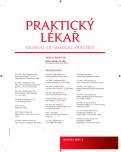Dog’s olfactory system in medicine and human malignant or other diseases
Authors:
D. Šubová; K. Azeem; H. Kollárová
Authors‘ workplace:
Lékařská fakulta Univerzity Palackého v Olomouci, Ústav preventivního lékařství, přednostka: doc. MUDr. Helena Kollárová, Ph. D.
Published in:
Prakt. Lék. 2015; 95(2): 52-58
Category:
Reviews
Overview
The aim of the article is to discuss question if the dogs and their olfactory systems can detect various kinds of human malignant tumours. These scientific experiments and hypotheses started more than 20 years ago. There are referring studies focused on the topic and overview of their results and success rate of dog’s distinguishing ability, too. In special laboratory, dogs distinguish the scents from breath, tissues or other body fluids, from the cancer patients and healthy controls. The accuracy of detection was significant and does not depend on the phase of cancer or variety of malignity. All around the world the major part of studies are confirming that dogs are able to detect scent of tumour with high significant sensitivity and specificity. Concurrently these part is discussing field of study of electronic nose and using canine olfactory ability for distinguish another diseases.
Keywords:
human cancer – tumour – sniffer dog – canine – olfactory system – scent – dog training – detection
Sources
1. Amundsen T, Sundstrom S, Buvik T, et. al. Can dogs smell lung cancer? First study using exhalted breath and urine screening in unselected patients with suspected lung cancer. Acta Oncologica 2014; 53(3): 307–315.
2. Bomers MK, van Agtmael MA, Luik H, et al. Using a dog’s superior olfactory sensitivity to identify Clostridium difficile in stools and patients: proof of principle study. BMJ 2012; 345: e7396.
3. Campbell LF, Farmery L, George SCG, et al. Canine olfactory detection of malignant melanoma. BMJ Case Report 2013 [online] [cit. 2014-04-23]. Dostupné z: http://casereports.bmj.com/content/2013/bcr-2013-008566.full.pdf.
4. Cornu JN, Cancel-Tassin G, Ondet V, et al. Olfactory detection of prostate cancer by dogs sniffing urine: a step forward in early diagnosis. Eur Urol 2011; 59(2): 197–201.
5. McCulloch, M, Jezierski, T, Broffman, M, et al. Diagnostic accuracy of canine scent detection in early- and late-stage lung and breast cancers. Integrative Cancer Therapies 2006; 5(1): 30–39.
6. Ehmann, R, Boedeker, E, Friedrich, U, et al. Canine scent detection in the diagnosis of lung cancer: revisiting a puzzling phenomenon. Eur Respir J 2012; 39(3): 669–676.
7. Elliker RK, Sommerville BA, Broom DM, et al. Key considerations for the experimental training and evaluation of cancer odour detection dogs: lessons learnt from a double-blind trial of prostate cancer detection. BMC Urol 2014; 14: 22. Dostupné z: http://www.ncbi.nlm.nih.gov/pmc/articles/PMC3945616/pdf/1471-2490-14-22.pdf.
8. Findejs J. Nedostižitelný čich psa. [on line] [cit. 2014-04-23]. Dostupné z: http://enssonbohemia.cz/index.php?option=com_content&task=view&id=148.
9. Gordon RT, Schatz CB, Myers LJ, et al. The use of canines in the detection of human cancers. J Altern Complement Med 2008; 14(1): 61–67.
10. Horvath G, Järverud GA, Järverud S, et al. Human ovarian carcinomas detected by specific odor. Integr Cancer Ther 2008; 7(2): 76–80.
11. Horvath G, Andersson H, Paulsson G. Characteristic odour in the blood reveals ovarian carcinoma. BMC Cancer 2010; 10: 643.
12. Jezierski,T, Górecka-Bruzda A, Walczak M. Operant conditioning of dogs (Canis familiaris) for identification of humans using scent lineup. Anim Sci Pap Rep 2010; 28(1): 81–93.
13. Lippi G, Cervellin G. Canine olfactory detection of cancer versus laboratory testing: myth or opportunity? Clin Chem Lab Med 2012; 50(3): 435–439.
14. Pickel D, Manucy PG, Walker DB, et al. Evidence for canine olfactory detection of melanoma. Appl Anim Behav Sci 2004; 89(1–2): 107–116.
15. Serpell J. Beneficial effects of pet ownership on some aspects of human health and behaviour. J R Soc Med 1991; 84(12): 717–720.
16. Sonoda H, Kohnoe S, Yamazato T, et al. Colorectal cancer screening with odour material by canine scent detection. Gut 2011; 60(6): 814–819.
17. Williams H, Pembroke A. Sniffer dogs in the melanoma clinic? Lancet 1989; 8640: 734.
18. Williams M, Johnston JM. Training and maintaining the performance of dogs (Canis familiaris) on an increasing number of odor discriminations in a controlled setting. Appl Anim Behav Sci 2002; 78(1): 55–65.
19. Willis CM, Church SM, Guest CM, et al. Olfactory detection of human bladder cancer by dogs: proof of principle study. BMJ 2004; 329(7468): 712.
20. Welsh JS. Olfactory detection of human bladder cancer by dogs: another cancer detected by „pet scan“. BMJ 2004; 329(7477): 1286–1287.
Labels
General practitioner for children and adolescents General practitioner for adultsArticle was published in
General Practitioner

2015 Issue 2
Most read in this issue
- Sinus pilonidalis sacrococcygealis
- Pseudotumor cerebri
- Job dissatisfaction of nurses in the Czech Republic
- Alcohol in primary health care: experiences and attitudes of Czech general practitioners
